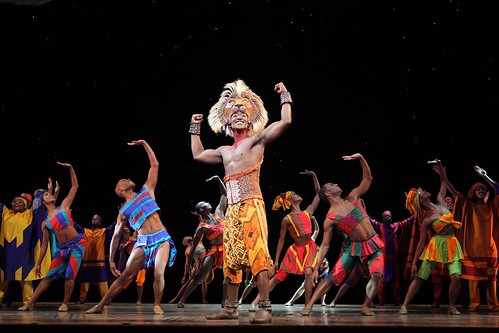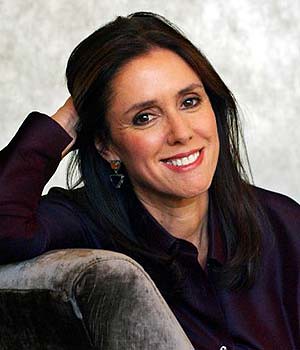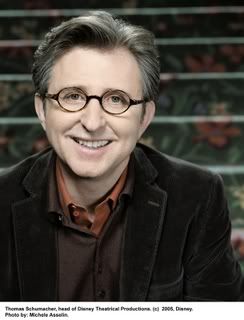Jelani Remy as Simba and the ensemble in “He Lives in You” from the touring production of Disney’s The Lion King. Photo by Joan Marcus
According to the Wall Street Journal, the King really is the King of Broadway.
News came down last month that Disney’s The Lion King is now Broadway’s all-time highest grossing show. It’s a title the regal hit stole from The Phantom of the Opera. The cumulative gross is staggering: $853,846,062 and counting.
Timing of the news couldn’t have come at a better time. Lion King‘s Tony Award-winning director, Julie Taymor, happened to be in town with producer and president of Disney Theatrical Productions President, Thomas Schumacher. They were with a small group at Pixar Animation Studios in Emeryville to promote the return of The Lion King to San Francisco this November as part of the SHN season at the Orpheum Theatre. That’s the same theater where the show made its Bay Area debut in 2004 and ran for 43 weeks.
Schumacher, a San Mateo native, was working in Disney’s animation division when The Lion King first began to make noise. “I realize I’ve been working in way or another on The Lion King, practically on a daily basis for 21 years,” Schumacher said. He remembers reading a four –page treatment called King of the Beasts, which was sort of like an animated National Geographic special. The movie, after the usual years of revisions and rewrites, went on to become an international smash movie with a musical score by Elton John and Tim Rice.
When talk turned to the possibility of bringing The Lion King to the stage as Disney had done successfully with Beauty and the Beast, Disney’s chairman at the time, Michael Eisner, whom Schumacher called a “brilliant but nutty guy,” wasn’t at all enamored of the lion idea. Schumacher remembers him saying something like, “Andrew Lloyd Webber already did a musical with cats.”
But Schumacher said he had a great idea. He called up that great idea, who happened to be Taymor, the rather brilliant off-Broadway and international opera director who is one of the last people you’d associate with a Disney musical based on an animated film.
Taymor remembered thinking it wasn’t all that much of a stretch to think of her applying her artistic talents to the Disney project. The film, after all, had a dark beauty to it. “When you think about it, the film is about a young child witnessing the death of his father.”
Having worked in Asia and absorbed many aspects of theater and puppetry there, Taymor was intrigued by the challenge and was delighted that Schumacher and his colleagues seemed open to her aesthetic.
“I don’t think we could open The Lion King today,” Schumacher said. “It took a certain renegade spirit to do it, and we wouldn’t have the same freedom today.”
When The Lion King opened on Broadway in the fall of 1997, it didn’t look like anything else in New York. It still doesn’t. With its extraordinary puppetry, masks, costumes and theatrical effects – many of which are centuries old – it’s an original fusion of international theater techniques combined with Taymor’s overriding vision, which makes it all feel of a piece.
The signature theme of the evening, visually speaking, is the circle – “The Circle of Life” is the centerpiece song of the show (and the basis for its jaw-dropping opening scene) – a theme you see in everything from the rising of the sun to the spinning of wheels as puppet deer leap across the stage on little wagons.
“It would be easy to do a sunrise projection,” Taymor explained. “But that would not be live theater. I wanted to stay away from anything like film. This was already a film. So our sun is bamboo and silk. Our audience knows that, but as it rises, light shimmering across it, it’s filled with spirit and soul.”
She also described the show as “magic and toys,” which are “the spirit of theater. It’s in our DNA going way back. It’s not about thinking. It’s about feeling.”
Taymor calls working on The Lion King “the most enjoyable work experience I’ve had…and here I am 15 years later.”
[bonus video]
FOR MORE INFORMATION
Disney’s The Lion King runs Nov. 1 through Jan. 13 at the Orpheum Theatre in San Francisco. Tickets are available as part of SHN’s 2012-13 season package. Subscriptions range from $197.50 to $567.50. Call 888-746-1799 or visit www.shnsf.com.



 In his highly enjoyable book How Does the Show Go On? An Introduction to the Theater (Disney Editions, $19.95), Thomas Schumacher recounts, in no particular order, all the jobs he’s had in his life, from childhood in San Mateo to the top of the heap as president of Disney Theatrical Productions.
In his highly enjoyable book How Does the Show Go On? An Introduction to the Theater (Disney Editions, $19.95), Thomas Schumacher recounts, in no particular order, all the jobs he’s had in his life, from childhood in San Mateo to the top of the heap as president of Disney Theatrical Productions. The showman in Schumacher, 50, also came out during the event. He brought a trunk of props from various Disney shows — a funny wig from Mary Poppins (made, as he told the kids, from “fur off a yak’s butt,” which you can bet got a laugh), a baby doll from Tarzan that “leaked” water on a volunteer from the audience, and a shattering vase from Poppins.
The showman in Schumacher, 50, also came out during the event. He brought a trunk of props from various Disney shows — a funny wig from Mary Poppins (made, as he told the kids, from “fur off a yak’s butt,” which you can bet got a laugh), a baby doll from Tarzan that “leaked” water on a volunteer from the audience, and a shattering vase from Poppins. After all he’s accomplished in his career, Schumacher finally got around to writing a book, the kind of book, he says, he would have been crazy about when he was a theater-hungry kid.
After all he’s accomplished in his career, Schumacher finally got around to writing a book, the kind of book, he says, he would have been crazy about when he was a theater-hungry kid. Now that Little Mermaid is up and running (after an opening delayed by the stagehands’ strike), Schumacher is turning his attention to other Disney Theatrical projects.
Now that Little Mermaid is up and running (after an opening delayed by the stagehands’ strike), Schumacher is turning his attention to other Disney Theatrical projects. In the realm of books about theater, this year’s standout comes from San Mateo native Thomas Schumacher, who also happens to be the president of Disney Theatrical, the producer of such hits as The Lion King and Mary Poppins. Schumacher’s How Does the Show Go On? An Introduction to the Theater (Disney Editions, $19.95) is geared toward the young theatergoer (ages 9 to 12), but it’s a hugely entertaining look at the entire theatrical picture, from the beginning of a show to the most intricate details of daily production.
In the realm of books about theater, this year’s standout comes from San Mateo native Thomas Schumacher, who also happens to be the president of Disney Theatrical, the producer of such hits as The Lion King and Mary Poppins. Schumacher’s How Does the Show Go On? An Introduction to the Theater (Disney Editions, $19.95) is geared toward the young theatergoer (ages 9 to 12), but it’s a hugely entertaining look at the entire theatrical picture, from the beginning of a show to the most intricate details of daily production. The Bay Area can’t get enough of the musical Jersey Boys. For the most avid fans, there is, of course, a coffee-table book. Jersey Boys: The Story of Frankie Vallie and the Four Seasons (Broadway, $40) contains the show’s libretto, lots of photos and a thorough guide to the real Four Seasons and their Broadway counterparts.
The Bay Area can’t get enough of the musical Jersey Boys. For the most avid fans, there is, of course, a coffee-table book. Jersey Boys: The Story of Frankie Vallie and the Four Seasons (Broadway, $40) contains the show’s libretto, lots of photos and a thorough guide to the real Four Seasons and their Broadway counterparts. The hottest show on Broadway is the multi-Tony Award-winning Spring Awakening. Fans already have memorized the great cast album, so give them Spring Awakening (Theatre Communications Group, $13.95), the libretto (by Steven Sater) and a new adaptation of Frank Wedekind’s original play by novelist Jonathan Franzen (Faber and Faber, $11.70). Franzen hates the musical, by the way, so it’s interesting to see how the play and the musical diverge.
The hottest show on Broadway is the multi-Tony Award-winning Spring Awakening. Fans already have memorized the great cast album, so give them Spring Awakening (Theatre Communications Group, $13.95), the libretto (by Steven Sater) and a new adaptation of Frank Wedekind’s original play by novelist Jonathan Franzen (Faber and Faber, $11.70). Franzen hates the musical, by the way, so it’s interesting to see how the play and the musical diverge.
 Once (20th Century Fox, $29.99), a fascinating and musically rich love story about an Irish street musician and an interesting woman he meets by chance; Colma: The Musical (Lionsgate, $27.98), a locally grown musical with catchy tunes and a better-than-average cast of characters. The best of the big-ticket DVD items this year is The Noel Coward Collection ($79.98 BBC/Warner), a veritable treasure trove of Cowardly delights. The set contains seven discs and runs some 19 hours (plus another 12 hours of bonus material that includes interviews, radio plays and more). The plays included are Private Lives (with the delectable Penelope Keith), Hay Fever, Design for Living, Present Laughter, A Song at Twilight, Mr. and Mrs. Edgehill and Tonight at 8:30.
Once (20th Century Fox, $29.99), a fascinating and musically rich love story about an Irish street musician and an interesting woman he meets by chance; Colma: The Musical (Lionsgate, $27.98), a locally grown musical with catchy tunes and a better-than-average cast of characters. The best of the big-ticket DVD items this year is The Noel Coward Collection ($79.98 BBC/Warner), a veritable treasure trove of Cowardly delights. The set contains seven discs and runs some 19 hours (plus another 12 hours of bonus material that includes interviews, radio plays and more). The plays included are Private Lives (with the delectable Penelope Keith), Hay Fever, Design for Living, Present Laughter, A Song at Twilight, Mr. and Mrs. Edgehill and Tonight at 8:30. The best of the bunch is Lauren Kennedy’s Here and Now, a marvelous collection of show music and pop. Album highlight is Andrew Lippa’s “Spread a Little Joy,” followed closely by Jason Robert Brown’s “In This Room” and Adam Guettel‘s “Through the Mountain” (from Floyd Collins). Kennedy’s voice is so vibrant — at times so Streisandian — it’s irresistible.
The best of the bunch is Lauren Kennedy’s Here and Now, a marvelous collection of show music and pop. Album highlight is Andrew Lippa’s “Spread a Little Joy,” followed closely by Jason Robert Brown’s “In This Room” and Adam Guettel‘s “Through the Mountain” (from Floyd Collins). Kennedy’s voice is so vibrant — at times so Streisandian — it’s irresistible. PS Classics’ Songwriter Series with the Library of Congress’ latest offering is a doozy: Jonathan Larson: Jonathan Sings Larson. The composer of Rent, who died tragically the night before his show opened, is heard singing demos and performing live, and the disc paints an incredible portrait of an artist full of talent, humor and ambition. The accompanying DVD features four live performances from Larson’s gig at New York’s Village Gate.
PS Classics’ Songwriter Series with the Library of Congress’ latest offering is a doozy: Jonathan Larson: Jonathan Sings Larson. The composer of Rent, who died tragically the night before his show opened, is heard singing demos and performing live, and the disc paints an incredible portrait of an artist full of talent, humor and ambition. The accompanying DVD features four live performances from Larson’s gig at New York’s Village Gate.
